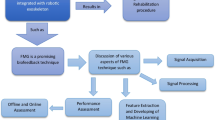Abstract
Two main difficulties are presented when a study of muscle forces is carried out. First, the complexity of modeling muscle behavior. Second, the impossibility of measuring all the needed parameters in order to tune the model for a specific subject. Since the first problem has been widely studied the aim of this work is to propose a new approach to estimate muscle parameters in a non-invasive way and with no additional measure. Thus, a general methodology to estimate parameters valid for any task is proposed. A particular task is performed in order to compare different set of parameters and to validate the new approach. Results show a good agreement between the forces got with the new set of parameters and the EMG records.
Access this chapter
Tax calculation will be finalised at checkout
Purchases are for personal use only
Similar content being viewed by others
References
Anderson, F.C., Pandy, M.G.: Static and dynamic optimization solutions for gait are practically equivalent. J. Biomech. 34, 153–161 (2001)
Chenut, X., Fisette, P.: Recursive formalism with a minimal dynamic parametrization for the identification and simulation of multibody systems. Application to the human body. Multibody Syst. Dyn. 7, 382–406 (2002)
Chrowninshield, R.D., Brand, R.A.: Physiologically based criterion of muscle force prediction in locomotion. J. Biomech. 14, 793–801 (1981)
Friederich, J.A., Brand, R.A.: Muscle fiber architecture in the human lower limb. J. Biomech. 23, 91–95 (1990)
Garner, B.A., Pandy, M.G.: Estimation of musculotendon properties in the human upper limb. Ann. Biomed. Eng. 31, 207–220 (2003)
Gerritsen, K.G.M., van den Bogert, A.J.: Intrinsic muscle properties facilitate locomotor control – a computer simulation study. Mot. Control. 2, 206–220 (1998)
Hill, A.V.: The heat of shortening and the dynamic constants of muscle. Proc. R. Soc. Lond. B 126, 136–195 (1938)
Lloyd, D.G., Besier, T.F.: An EMG-driven musculoskeletal model to estimate muscle forces and knee joint moments in vivo. J. Biomech. 36, 765–776 (2003)
Nigg, B.M., Herzog, W.: Biomechanics of the Musculo-Skeletal System. Wiley, Chichester (2007)
Pierce, J.E., Li, G.: Muscle forces predicted using optimization methods are coordinate system dependent. J. Biomech. 38, 695–702 (2005)
Ward, S.R., Smallwood, L.H., Lieber, R.L.: Scaling of human lower extremity muscle architecture to skeletal dimensions. In: ISB XXth Congress, Cleveland (2005)
Ward, S.R., Eng, C.M., Smallwood, L.H., Lieber, R.L.: Are current measurements of lower extremity muscle architecture accurate? Clin. Orthop. Relat. Res. 467, 1074–1082 (2009)
Wickiewicz, T.L., Roy, R.R., Powell, P.L., Edgerton, V.R.: Muscle architecture of the human lower limb. Clin. Orthop. Relat. Res. 179, 275–283 (1983)
Winby, C.R., Lloyd, D.G., Kirk, B.: Evaluation of different analytical methods for subject-specific scaling of musculotendon parameters. J. Biomech. 41, 1682–1688 (2008)
Zajac, F.E.: Muscle and tendon: properties, models, scaling, and application to biomechanics and motor control. CRC Crit. Rev. Biomed. Eng. 17, 359–411 (1989)
Acknowledgments
This work was funded by the Spanish Ministry of Education and Science as a part of project DPI2009-11792 and by the Junta de Andalucía as a part of Excellence Project TEP03115.
Author information
Authors and Affiliations
Corresponding author
Editor information
Editors and Affiliations
Rights and permissions
Copyright information
© 2013 Springer Science+Business Media Dordrecht
About this paper
Cite this paper
Ojeda, J., Mayo, J. (2013). A New Approach to Estimate a Subject-Specific Set of Muscle Parameters. In: Viadero, F., Ceccarelli, M. (eds) New Trends in Mechanism and Machine Science. Mechanisms and Machine Science, vol 7. Springer, Dordrecht. https://doi.org/10.1007/978-94-007-4902-3_51
Download citation
DOI: https://doi.org/10.1007/978-94-007-4902-3_51
Published:
Publisher Name: Springer, Dordrecht
Print ISBN: 978-94-007-4901-6
Online ISBN: 978-94-007-4902-3
eBook Packages: EngineeringEngineering (R0)




